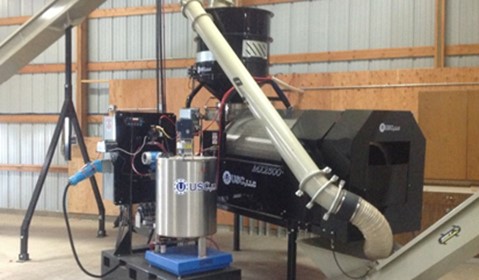
Recently, I had the opportunity to attend a training seminar about seed treatment at Syngenta’s Seedcare Institute in Stanton, MN. The Seedcare Institute in Stanton is dedicated solely for the development and testing of seed treatments, and it is 1 of 13 stations worldwide. Needless to say, I was quite impressed with the staff and facilities there. As many of you know, WS Ag has a seed treater that allows us to treat seed with a variety of seed treatments, inoculants, micronutrients, or any number of other seed applied products. A vast majority of what we treat soybeans with is CruiserMaxx Vibrance seed treatment and Optimize XC inoculant. The main points I would like to share is the transparency with regards to our products and the value of treating your soybeans.
CruiserMaxx Vibrance is a premix of three different fungicide modes of action and one insecticide mode of action. The main diseases that it controls are Pythium, Phytophthora, Fusarium, and Rhizoctonia; and the main insect pests that it controls are wireworm, white grub, and seed corn maggot to name a few. Optimize XC is a living bacterium that forms the nodules on the roots so the soybeans can fixate their own nitrogen. Once applied to the seed, Optimize with last for 120 days and its low use rate reduces the tendency for seeds to stick together after they are put through the treater. Soybean inoculants are critical for a field that will be soybeans for the first time and are a cheap insurance policy for fields planted to soybeans in a rotation.
A question that I get this time of year is do I need to use a seed treatment on my soybeans? The quick answer to that most of the time is yes. University of Wisconsin Extension has dedicated a lot of research to this topic over the years and they’ve found that the return on investment for soybean seed treatments is above breakeven 70 to 80% of the time in this state. The general guidelines that I like to follow are if you are planting your soybeans in April or early to mid-May, you should treat your soybeans regardless of soil temperature, tillage, soil type, or row spacing. If you are planting soybeans at the end of May or in June, you are probably better off planting untreated soybeans as a positive return on investment isn’t as common with seed treatment. On a side note if you are planting soybeans following soybeans, you should always treat your soybeans as disease, insect, and nematode pests rapidly build up in the soil. A couple of pests that require separate discussion from general fungicide/insecticide seed treatments are Soybean Cyst Nematode (SCN) and Sudden Death Syndrome (SDS). Across all US soybean acres, these are two of the most economically damaging pests that we face. Breeding for soybeans resistant to SCN has been an effective method of control for many years but almost all resistant varieties contained the same gene. Areas of the Midwest are finding that the gene is no longer effective at controlling SCN. SDS was a common soybean yield robber in southwest Wisconsin back in 2016. SDS symptoms can be enhanced by SCN because the nematodes create scars in the roots for SDS to infect soybean seedlings. If you are concerned about nematodes, UW Extension offers every farmer four free nematode samples each year which are about as simple as pulling soil cores for soil testing. If you have field history of SCN or SDS, there are products we can apply to the seed to control them. Clariva Pn contains a soil bacterium that feeds on cyst nematodes and since it is a living predator, it can provide season long control of SCN. Mertect 340-F is a fungicide that will control SDS during the early part of the growing season when SDS infects the young soybean seedlings.
The key point that I would like you to take away is that seed treatments have become quite complicated and it is important to know your field history and what is in your seed treatment. So I would encourage you to sit down with an agronomist at WS Ag if you want to talk more about what treatment is going on your seed this season.
– Mark Kendall